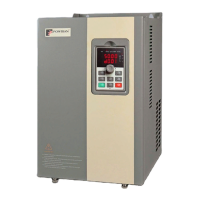Chapter 6 Troubleshooting
51
the motor stall occurs
2.The type selection of inverter is
small
the motor and its mechanical
conditions
2.Choose the inverter with
large power level
Switch motor
when running
fault
Change current motor through the
terminal when the inverter is
running
Switch motor after the inverter
stops
1.Check E8.16, 2 E8.48 parameters,
2. Pressure feedback value lines or
feedback device problem
3.Burst water pipe
1.Set E8.16 and E8.48 correctly
2. Check the circuit or pressure
feedback device
3. Check water pipes
Check E8.18, 2 E8.49 parameters
Set E8.18 and E8.49 correctly
Add or subtract pump error
Power off and run it again
The deviation between the motor
parameters and the actual
parameters is too large
Reconfirm the correct motor
parameters, focus on whether
the rated current is set to too
small.
1.Keyboard interface control board
interface;
2.Keyboard or crystal connector;
3.Control board or keyboard
hardware damage;
4.Keyboard line is too long,
causing the interference.
1.Detection of keyboard
interface, control board
interface is abnorma.
2.Detect keyboard, crystal
joints are abnormal.
3.Replace control board or
keyboard.
4. Consult factory, seek help.
6-2.EMC (Electromagnetic compatibility)
6-2-1.Definition
Electromagnetic compatibility refers to the ability that the electric equipment runs in an
electromagnetic interference environment and implements its function stably without interferences
on the electromagnetic environment.
6-2-2.EMC standard
In accordance with the requirements of the Chinese national standard GB 12668.3-2012/IEC
61800-3:2004, the inverter must comply with the requirements of electromagnetic interference and
anti- electromagnetic interference.
Our existing products adopt the latest international standards: IEC/EN61800-3: 2004
(Adjustable speed electrical Power drive systems Part 3: EMC requirements and specific test
methods), which is equivalent to the Chinese national standards GB 12668.3-2012/IEC 61800-
3:2004. EC/EN61800-3 assesses the inverter in terms of electromagnetic interference and anti-
electronic interference. Electromagnetic interference mainly tests the radiation interference,
conduction interference and harmonics interference on the inverter (necessary for civil inverter).
Anti-electromagnetic interference mainly tests the conduction immunity, radiation immunity,
surge immunity, EFTB(Electrical Fast Transient Burs) immunity, ESD immunity and power low
frequency end immunity (the specific test items includes: 1. Immunity tests of input voltage sag,
interrupt and change; 2.Commutation notch immunity; 3. harmonic input immunity ; 4. input
frequency change; 5. input voltage unbalance; 6. input voltage fluctuation). The tests shall be
conducted strictly in accordance with the above requirements of IEC/EN61800-3, and our products
are installed and used according to the guideline of the Section 6-3 and can provide good
electromagnetic compatibility in general industry environment.
6-3.EMC directive
6-3-1.Harmonic effect
The higher harmonics of power supply may damage the inverter. Thus, at some places where

